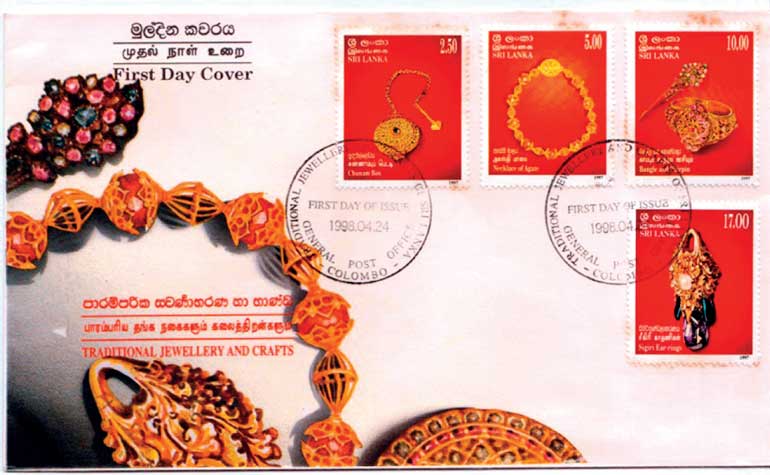Sunday Oct 26, 2025
Sunday Oct 26, 2025
Saturday, 13 February 2016 00:00 - - {{hitsCtrl.values.hits}}


Sri Lanka’s gems hit the headlines every now and then. Recently we read about the “priceless Blue Sapphire” and before that there was the “Blue Belle of Asia” referring to a 392 carat Blue Sapphire which was sold for $ 17.3 million.
Displayed in the American Museum of Natural History is the beautiful 563 carat Star Sapphire ‘misnamed’ the “Star of India”. Among the possessions of Queen Elizabeth II is a 104 carat Stuart Sapphire. All these are from the ‘Ratana Dipa’ (Island of Gems as Sri Lanka was once known) – mainly from Ratnapura, the ‘Gem City’.
European travellers to the East in the Middle Ages had spoken of the “sapphires, topazes, amethysts, garnets, and other costly stones” of Sri Lanka. Among them was the 13th century traveller, Marco Polo, who described the ruby belonging to the king “a span in length, the thickness of a man’s arm, brilliant beyond description and without a single flaw”.
Kublai Khan, the Moghul Emperor, is supposed to have sent emissaries to offer for the ruby “the value of a city but the king would not part with it for all the treasures of the world, as it was a jewel handed down by his ancestors on the throne”.
Precious stones had been exported from early times with historians quoting that in exchange for gems, pearls and chank shells, India sent slaves, chariots and horses.
“The islanders cultivate rice, coconuts and sugar cane; in the rivers is found rock crystal, remarkable both for brilliancy and size, and the sea on every side has a fishery of magnificent and priceless pearls. Throughout India there is no prince whose wealth can compare with the King of Serendib, his immense riches, his pearls and his jewels, being the produce of his own dominions and seas,” says Edrisi, a renowned 12th century writer on geography of the East.
Gems and jewellery go hand in hand. Sri Lanka has a rich history and tradition of jewellery and jewellery making. Evidence of this tradition can be seen at the Colombo National Museum where jewels dating back to the time of King Kasyapa (5th century) are exhibited. Today, a modern and vibrant jewellery manufacturing industry caters to the taste of discerning tourists and sophisticated export markets.
Ranking as the fourth among exports, gems and jewellery brought in around $ 384 million in export income in 2014. An estimated 500,000 are employed in the industry. These include gem miners, dealers, gem cutters, designers, jewellery craftsmen and sales persons.
Last September, Facets Sri Lanka International Gem and Jewellery Exhibition celebrated its 25th anniversary. The Philatelic Bureau issued a set of four stamps featuring jewellery and gems to mark the event. The types of gems featured were Star Sapphire – ‘Aarunul’ in Sinhala (Rs 10 stamp), Blue Sapphire – ‘Nil Menik’ (Rs 25), Cat’s Eye – ‘Vairodi’ (Rs 35) & Padparadscha – ‘Padmaraga’ (Rs 50).
The much-valued and the much talked-about Blue Sapphire, belonging to the corundum family of gemstones, is known for its beauty, for its glorious cornflower blue shade with a fine velvety lustre, and for being one of the few sapphires in the world that can be sold as a completely natural stone without heat treatment.
The Star Sapphire, also known as the Star Ruby, shows a star-like marking or effect, commonly known as asterism. This can be seen when light falls on the cut stone when three rays appear giving a six-point star.
The Cat’s Eye is so called due to its effect known as ‘chatoyancy,’ which appears to move on the stone’s surface. It is a gem variety of Chrysoberyl, the name given to transparent, faceted gemstone that does not show a colour change between daylight and artificial light. The Chrysoberyl which shows a colour change is called Alexandrite.
The ideal colours of the Cat’s Eye are yellowish-brown called the honey colour, and yellow green which is called the apple green colour. A very good cat’s eye should also have a high degree of transparency and a well-defined unbroken ray.
The Padparadscha Sapphire has been named after the lotus.
The Ruby is an aluminium oxide and is a variety of corundum. It occurs in medium to dark tones of red and violetish- red to brownish-red. The colour has often been compared to the blood of a pigeon.
‘Gems of Sri Lanka’ was the theme of a set of stamps issued on 16 June 1976 featuring four varieties of gems described above.
‘Traditional Jewellery and Crafts’ was the theme of a set of four stamps released on 24 April 1904. They show how intricate the workmanship has been in the years gone by.
At a time when betel chewing was a common practice, the chunam box used as a container to keep lime was a useful utility object. The circular Chunam Box seen in the Rs. 2.50 stamp is a fine example of how much intricate the design had been in that era. It is a lotus design set with rubies and sapphires. A chain was attached to the box for the convenience of taking it around.
The Agasti Necklace (Rs. 5) continues to a popular piece of jewellery among the Kandyan aristocracy. It contains nine agate beads, 18 gold filigree calyxes, 10 gold beads and a circular piece with two hooks.
The Bangle and Hairpin (Rs. 10) are mainly worn by females in the South. The silver gilt bangle, ornate with a floral design is set with 108 rubies. The gold hairpin is studded with 18 red stones and five pearls.
The unique Kundalabharana (Rs. 17) ear ornament –is made of gold and studded with gems. Generally referred to as the ‘Sigiri ear ornament’, its body is formed by a set of intricate scrolls, bursting out like a series of flames.
The upper part consists of a smooth loop which can be opened for it to be attached to the year.